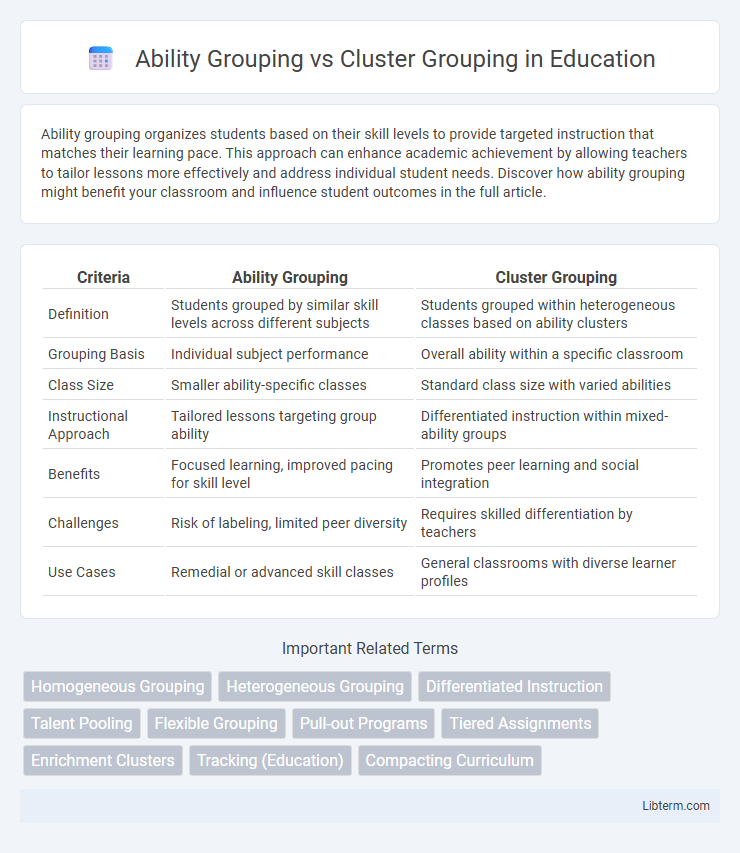Ability grouping organizes students based on their skill levels to provide targeted instruction that matches their learning pace. This approach can enhance academic achievement by allowing teachers to tailor lessons more effectively and address individual student needs. Discover how ability grouping might benefit your classroom and influence student outcomes in the full article.
Table of Comparison
| Criteria | Ability Grouping | Cluster Grouping |
|---|---|---|
| Definition | Students grouped by similar skill levels across different subjects | Students grouped within heterogeneous classes based on ability clusters |
| Grouping Basis | Individual subject performance | Overall ability within a specific classroom |
| Class Size | Smaller ability-specific classes | Standard class size with varied abilities |
| Instructional Approach | Tailored lessons targeting group ability | Differentiated instruction within mixed-ability groups |
| Benefits | Focused learning, improved pacing for skill level | Promotes peer learning and social integration |
| Challenges | Risk of labeling, limited peer diversity | Requires skilled differentiation by teachers |
| Use Cases | Remedial or advanced skill classes | General classrooms with diverse learner profiles |
Introduction to Ability and Cluster Grouping
Ability grouping organizes students by similar skill levels within a single classroom or grade, enhancing targeted instruction and tailored learning experiences. Cluster grouping places high-achieving students together within a heterogeneous classroom, promoting challenge while maintaining social integration. Both strategies aim to optimize educational outcomes by addressing diverse learner needs through distinct grouping methods.
Definitions: Ability Grouping vs Cluster Grouping
Ability grouping refers to the educational practice of organizing students into groups based on their individual skill levels or academic performance to tailor instruction more effectively. Cluster grouping, in contrast, involves placing a small group of high-achieving or gifted students within a heterogeneous classroom to provide targeted enrichment while maintaining a diverse learning environment. Both strategies aim to optimize instruction but differ primarily in group composition and setting.
Historical Perspective and Evolution
Ability grouping emerged in the early 20th century, influenced by intelligence testing and a desire to tailor instruction to students' skill levels, while cluster grouping developed later as a method to group gifted or high-achieving students within heterogeneous classrooms. Over time, ability grouping faced criticism for reinforcing educational inequalities, leading educators to explore cluster grouping as a more inclusive strategy that maintains diversity within the classroom. The evolution of these grouping methods reflects ongoing shifts in educational philosophy from rigid stratification toward more flexible, equitable approaches to differentiated instruction.
Key Differences Between Ability and Cluster Grouping
Ability grouping organizes students based on individual skill levels within a single subject, allowing tailored instruction to meet specific learning needs. Cluster grouping places diverse students into heterogeneous groups, fostering peer interaction and collaborative learning across varying abilities. The key difference lies in ability grouping's focus on homogeneous skill-level cohorts versus cluster grouping's emphasis on mixed-ability social and academic integration.
Benefits of Ability Grouping
Ability grouping enhances student learning by tailoring instruction to specific skill levels, which increases engagement and accelerates academic progress. It allows teachers to design targeted lessons that address the unique needs of each ability group, improving mastery and confidence. Research shows students in ability groups often demonstrate higher achievement and motivation compared to mixed-ability clusters.
Advantages of Cluster Grouping
Cluster grouping enhances personalized instruction by grouping students with diverse abilities working together, promoting peer learning and collaboration. It allows teachers to tailor lessons that address a range of skill levels within the same group, fostering social development and reducing stigmatization often associated with ability grouping. Research indicates cluster grouping improves overall classroom dynamics and supports differentiated instruction more effectively than rigid ability grouping.
Challenges and Criticisms of Each Method
Ability grouping often faces criticism for reinforcing achievement gaps and limiting peer learning by segregating students based on perceived skill levels, which can lead to stigmatization and reduced motivation among lower groups. Cluster grouping, while promoting heterogeneous learning experiences within small, mixed-ability groups, encounters challenges in maintaining balanced group dynamics and ensuring instructors meet diverse needs effectively. Both methods demand careful implementation and ongoing assessment to mitigate potential drawbacks such as social division or instructional complexity.
Impact on Student Achievement
Ability grouping organizes students based on their individual skill levels, often leading to tailored instruction that can improve achievement for high-performing learners but may limit exposure to diverse perspectives for lower-achieving students. Cluster grouping places high-ability students together within a mixed-ability classroom, promoting peer interaction and differentiated instruction, which research suggests can enhance motivation and academic growth across varied achievement levels. Studies indicate that both methods impact student achievement differently, with cluster grouping often fostering a more inclusive environment that benefits a wider range of learners.
Educator and Parent Perspectives
Educators value ability grouping for its targeted instruction tailored to students' specific skill levels, improving both challenge and support within the classroom; parents often appreciate the clarity it provides about their child's academic standing but can be concerned about potential stigmatization. Cluster grouping, favored by many educators for gifted students, allows grouping high-ability learners in mixed-ability classrooms, fostering peer interaction and differentiated instruction while parents see it as a balance between academic rigor and social integration. Both grouping strategies require careful implementation and communication to address concerns related to equity, student self-esteem, and overall learning outcomes.
Best Practices for Implementing Ability and Cluster Grouping
Effective implementation of ability grouping requires clear criteria based on student skill levels and ongoing assessments to ensure accurate placement and targeted instruction. Cluster grouping benefits from assembling mixed-ability groups centered around higher-performing students to promote peer support and cooperative learning. Best practices include regular monitoring of group dynamics, flexibility to reassign students as needed, and professional development for teachers to manage diverse group needs effectively.
Ability Grouping Infographic

 libterm.com
libterm.com